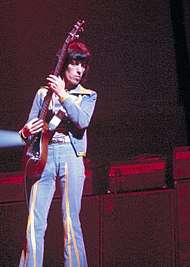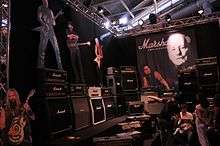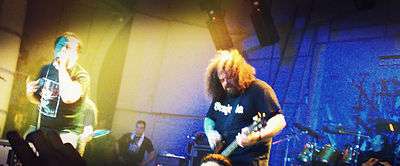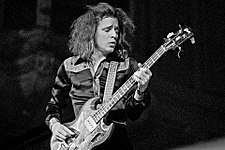Fuzz bass
Fuzz bass, also called "bass overdrive" or "bass distortion", is a style of playing the electric bass or modifying its signal that produces a buzzy, distorted, overdriven sound, which the name implies in an onomatopoetic fashion. Overdriving a bass signal significantly changes the timbre, adds higher overtones (harmonics), increases the sustain, and, if the gain is turned up high enough, creates a "breaking up" sound characterized by a growling, buzzy tone.
| String instrument | |
|---|---|
| Classification | String instrument (fingered or picked or strummed) |
| Developed | 1960s |


One of the earliest examples may be the 1961 Marty Robbins Country and Western song "Don't Worry."[1] By the mid- to late-1960s, a number of bands began to list "fuzz bass" in addition to "electric bass" on their album credits. Two well-known examples are the Beatles' 1965 song "Think for Yourself" (from Rubber Soul), which marked the first instance of a bass guitar being recorded through a distortion unit,[2] and the 1966 Rolling Stones song "Under My Thumb". Album or performance credits for fuzz bass can be found from every decade since then (see examples below).
Fuzz bass can be produced by overloading a bass amp's tube or transistor preamplifier, by using a bass fuzz or bass overdrive effect pedal, or for the most powerful effect, by combining both approaches. In the 1960s and early 1970s fuzz bass was associated with the psychedelic music (e.g., Edgar Broughton Band), progressive rock (e.g., Genesis), and psychedelic soul/funk (e.g., Sly and the Family Stone) styles, and it tended to be a "warmer", "smoother", and "softer" overdrive-type sound caused by soft, symmetrical clipping of the audio signal that "round[ed] off the signal peaks rather than razor-slicing"[3] them and filtered out the harsher high harmonics.
In the 1980s and 1990s, overdriven bass tended to be associated with hardcore punk (e.g., Stormtroopers of Death), death metal (e.g., Mortician), grindcore (e.g., Napalm Death) and Industrial bands (e.g., Ministry), and the tone tended to be heavier, more metallic and more grinding. This is achieved by hard clipping of the bass signal, which leaves in "harsher high harmonics that can result in sounds that are heard as jagged and spiky."[4] Fuzz bass has been used by indie, alternative rock and hard rock bands such as Muse and Royal Blood.
Approaches
In the context of electric guitars, the terms "distortion", "overdrive" and "fuzz" are often used interchangeably, but they have subtle differences in meaning.
- Overdrive effects are the mildest of the three, producing "warm" natural overtones at quieter volumes and harsher distortion as gain is increased. The best quality overdrive effects respond to how hard the bassist picks or plucks the bass, producing little or no distortion when the instrument is played quietly, but gradually adding overdrive as the instrument is played harder.
- A "distortion" effect produces approximately the same amount of distortion at any volume, and its sound alterations are much more pronounced and intense.[5][6]
- A fuzzbox (or "fuzz box”) alters an audio signal until it is nearly a square wave and adds complex overtones by way of a frequency multiplier.[7]

A fuzz bass sound can be created by turning up the volume of a tube amp or transistor amp to the point that preamplifier tube (or transistor preamp) clipping" occurs. In practice, when a bass amp is "cranked" to its maximum volume, the fuzz tone will also include some power amplifier clipping. While some musicians seek out the additional "grit" provided by power amp clipping, audio engineers and bass technicians recommend avoiding power amp clipping, as it can blow speakers.
Fuzz bass can be produced by using an electric guitar fuzz, distortion or overdrive pedal. The downside of using a pedal designed for the electric guitar is that the lower-end bass tone is mostly lost when the signal is heavily clipped.
Clipping is a form of waveform distortion that occurs when an amplifier is overdriven and attempts to deliver an output voltage or current beyond its maximum capability. Driving an amplifier into clipping may cause it to output power in excess of its published ratings. Clipping is a non-linear process that produces frequencies not originally present in the audio signal.
These frequencies can either be "harmonic", meaning they are whole number multiples of the signal's original frequencies, or "inharmonic", meaning dissonant odd-order overtones.[8][9] Harmonic distortion produces harmonically related overtones while intermodulation distortion produces inharmonic overtones.[10] "Soft clipping" gradually flattens the peaks of a signal and de-emphasizes higher odd harmonics. "Hard clipping" flattens peaks abruptly, resulting in harsh-sounding, high amplitude odd harmonics.[11]
Since the late 1980s, manufacturers have been producing bass overdrive pedals specifically designed for the electric bass, and in many cases they found a way to keep the low fundamental pitch in along with the buzzy overdrive tone. One early model was the Ibanez "Bass Stack" bass overdrive pedal, which was sold in the late 1980s.[12]
| External video | |
|---|---|
1980s grindcore groups, such as Napalm Death in the sound clip to the right, used a very heavy, distorted bass tone that resembles the sound of a grinding buzz saw.
The simplest fuzz bass pedals have knobs for controlling the volume level, the tone, and the fuzz or overdrive effect. More complex pedals have different distortion effects (e.g., overdrive and fuzz), gates to trigger the volume at which sounds will get overdriven, mixers to mix the natural and fuzzed sound in the player's desired proportions, and multiple band equalizers (typically for low and high frequencies). Boutique fuzz bass pedals even have unusual effects such as a "starve" effect, which mimics the distortion sound a pedal gives with a dying battery, a diode selector (either silicon or germanium) for selecting the transistor overdrive tone, and an octave selector (above or below the pitch being played).
While fuzz bass pedals are most commonly used by bass players, some electric guitar players use bass overdrive units. Buzz Osborne, electric guitarist from the Melvins, uses a BOSS Bass Overdrive ODB-3 pedal.[13]
Overdrive built into amplifiers

Some bass amplifiers have an "overdrive" or distortion effect built into the unit. The Peavey Century 200 has an onboard "distortion" effect on the second channel. The Peavey VB-2 also has built-in overdrive. Aguilar Amplification's AG 500 bass head is a two-channel amplifier, one of which offers a "saturation" control for overdrive. A variety of BOSS combo amplifiers have a built-in "drive" effect. Gallien-Krueger's bass amp heads have a "boost" control that provides a simulated tube overdrive effect. The Behringer Ultrabass BVT5500H Bass Amplifier Head has a built-in limiter and overdrive. The LowDown LD 150 bass amp has a range of overdrive sounds, from a slight hint to heavy distortion. The CUBE-20XL BASS amp includes built-in overdrive.
The 75W Fender Rumble 75 Bass Combo Amp can produce an overdrive effect by using the gain and blend controls, giving overdrive sounds ranging from "mellow warmth [to] heavy distorted tones".[14] The Fender SuperBassman is a 300-watt tube head that has a built-in overdrive channel. The Fender Bronco 40 includes a range of effects including modern bass overdrive, vintage overdrive and fuzz.

The MESA Bigblock 750 has a built-in overdrive channel. The Mesa M2000 has a high gain switch that can be engaged with a footswitch. The Marshall MB450 head and combo bass amplifiers have a tube pre-amp on the "Classic" channel that can be overdriven. The Ashdown ABM 500 EVO III 575W Bass amp head has a built-in overdrive effect. Overdrive is also available on many Crate bass amplifiers. The Yamaha BBT500H has three types of built-in drive effects: overdrive, distortion and fuzz. The Ampeg B5R Bass Amplifier has two channels: clean and overdrive, with the ability to combine the two. The Orange has introduced a new line of bass amplifiers(OB 1 series) with a built in fuzz.
Verellen, a boutique amp company, produces a bass amplifier with a built in overdrive channel.
Selected songs
The following section gives examples of songs that feature fuzz bass.

2010s
- Ed Sheeran, "Don't".
- Royal Blood, "Figure It Out", "Lights Out"
- Bring Me The Horizon, "MANTRA", "Sugar Honey Ice & Tea", "Heavy Metal"
- Arctic Monkeys, "Do I Wanna Know?"
- Muse, "Mercy", "The Handler", "Liquid State"
2000s
- Vader, "Fear of Napalm".
- Yellow Matter Custard, a Beatles tribute supergroup active from 2003 to 2011, credits Neal Morse with keyboards, guitars, vocals, and fuzz bass.
- "Staring at the Sun", TV on the Radio.
- Low, Things We Lost In the Fire onward.
- Radiohead, "The National Anthem".
- Muse, "Hysteria" and "Uprising".[15]
1990s
- Ben Folds Five, "Uncle Walter."
- Nine Inch Nails, "We're in This Together".
- Marianne Faithfull, Vagabond Ways.
- The Jesus and Mary Chain, "Sometimes Always", "Hole" and "Never Saw it Coming" from the album "Stoned & Dethroned".
- Neutral Milk Hotel, On Avery Island, tracks 2 and 8, and In the Aeroplane Over the Sea.
- Motörhead, "I Don't Believe a Word".
- Ministry, "Filth Pig".
- Mortician, "Drilling For Brains" and "Hacked Up For Barbecue".
- Mouth to Mouth", The Blackeyed Susans.

- Nirvana, "Breed" from Nevermind.[16]
- Sloan, "Snowsuit Sound".
- Red Hot Chili Peppers, "Around the World".
- Radiohead, "Exit Music (For a Film)" from the album OK Computer.
- Type O Negative.
- Blur, "Song 2".
1980s
- Motörhead
- Elvis Costello, "Spike".
- Metallica Kill 'Em All, "(Anesthesia) - Pulling Teeth". Ride the Lightning, "For Whom the Bell Tolls", "The Call of Ktulu"; Master of Puppets, "Damage, Inc.", "Orion", "The Thing That Should Not Be".
- Extreme Noise Terror, "Deceived".
- The Clash, "Should I Stay or Should I Go"
- Faith No More, "Epic", "The Real Thing"
1970s
- Jean-Luc Ponty, Enigmatic Ocean.
- Frank Zappa, Apostrophe (').[17]
- Emerson Lake & Palmer, Tarkus.
- Yes, "Roundabout".
- Tamam Shud, "Goolutionites and the Real People", "Got A Feeling".
- Mike Rutherford of Genesis.
- The Velvet Underground, "Sweet Jane".
- Curtis Mayfield, "(Don't Worry) If There's a Hell Below, We're All Going to Go".
- Sir Lord Baltimore, Kingdom Come[17]

- King Crimson[18]
- Truth and Janey.
- Steely Dan, "Monkey in Your Soul,", Pretzel Logic.
1960s
- "21st Century Schizoid Man", King Crimson.
- "Inside Looking Out," Grand Funk Railroad.
- Cream, Goodbye[17].
- Edgar Broughton Band, Wasa Wasa (1969).[17]
- The Litter, Emerge.[17]
- "Some Velvet Morning", Vanilla Fudge.
- "Dance to the Music", Sly and the Family Stone.
- Genesis, In the Beginning, "Mary, Mary".
- The Monkees, "Valleri".
- The Velvet Underground, "White Light White Heat" and "The Gift".
- The United States of America.[17]
- "Sodding About", The Who.
- "Zig-Zag Wanderer", Safe As Milk, Captain Beefheart & His Magic Band.
- Jefferson Airplane, "She Has Funny Cars", "Ballad of You and Me and Pooneil".[19]
- "Talk, Talk", The Music Machine.
- "Open Up Your Door", Richard and the Young Lions.
- The Rolling Stones, "Under My Thumb".
- Captain Beefheart & His Magic Band, "Diddy Wah Diddy".
- "Let's Hang On!", by Bob Crewe, Sandy Linzer, and Denny Randell.
- The Beatles, "Think for Yourself", "Ob-La-Di, Ob-La-Da", "While My Guitar Gently Weeps", "Mean Mr. Mustard" and "Sun King".[20]
- Roy Orbison, "Lana".
- Marty Robbins, "Don't Worry".[21]
.jpg)
References
- The song features fuzzy, low-pitched guitar breaks. Some sources suggest this may be baritone guitar, rather than an electric bass.
- Everett, Walter (2009). The Foundations of Rock: From "Blue Suede Shoes" to "Suite: Judy Blue Eyes"'. New York, NY: Oxford University Press. p. 33. ISBN 978-0-19-531024-5.
- "Howard Davis: Soft, Hard, & Intermodulation Distortion Explained". howardmickdavis.com. Retrieved 24 February 2017.
- "Archived copy". Archived from the original on 2015-12-22. Retrieved 2014-02-09.CS1 maint: archived copy as title (link)
- Zölzer, Udo; Amatriain, Xavier (2002). DAFX: Digital Audio Effects. John Wiley and Sons. p. 117.
- Brewster, David M. (2001), Introduction to Guitar Tone and Effects: A Manual for Getting the Sounds from Electric Guitars, Amplifiers, Effects Pedals and Processors, Hal Leonard, p. 18
- Holmes, Thom (2006). The Routledge Guide to Music Technology. CRC Press. p. 177. ISBN 0-415-97324-4.
- Case, Alexander U. (2007). Sound FX: Unlocking the Creative Potential of Recording Studio Effects. Elsevier. p. 96.
- Davis, Gary; Davis, Gary D.; Jones, Ralph (1989). The Sound Reinforcement Handbook. Hal Leonard. p. 112. ISBN 0-88188-900-8.
- Newell, Philip (2007). Recording Studio Design. Focal Press. p. 464.
- Dailey, Denton J. (2011). Electronics for Guitarists. Springer. p. 141.
- blitzpulver (13 March 2013). "Ibanez Bass Stack BS10". Retrieved 24 February 2017 – via YouTube.
- http://www.gibson.com/News-Lifestyle/Features/en-us/the-melvins-king-buzzo-lays-do.aspx
- "Fender Rumble 75 75W 1x12 Bass Combo Amp". musiciansfriend.com. Retrieved 24 February 2017.
- BassPlayer.com, Electric & Acoustic Bass Gear, Lessons, News, Video, Tabs and Chords -. "Too Much Is Never Enough: Muse's Chris Wolstenholme Reinvents Art-Rock Bass For The 21st Century". Retrieved 2018-02-19.
- "Mojo Magazine #54 - May 1998". livenirvana.com. Retrieved 22 October 2018.
- "Jefferson Airplane discography". rateyourmusic.com. Retrieved 24 February 2017.
- "John's 1974 touring gear - The Official John Wetton Website Guestbook". forumchitchat.com. Retrieved 24 February 2017.
- "YouTube". youtube.com. Retrieved 24 February 2017.
- Babiuk, Andy (2002). Beatles Gear. Hal Leonard. p. 173. ISBN 0-87930-731-5.
- "YouTube". youtube.com. Retrieved 24 February 2017.